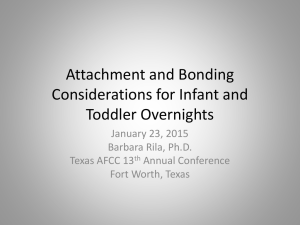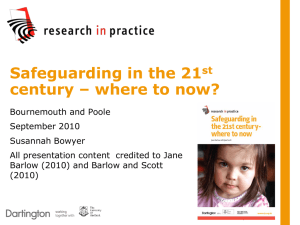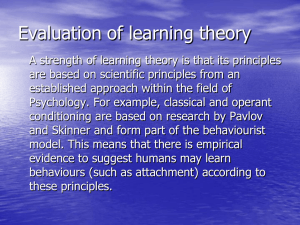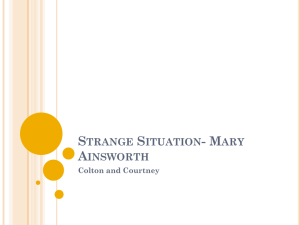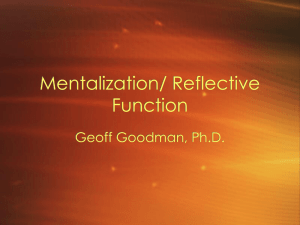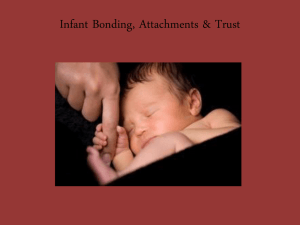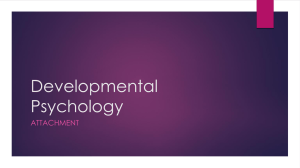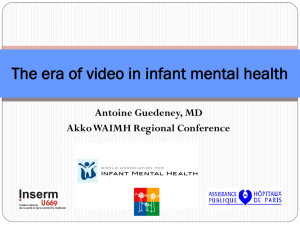stirling_june_2011 - The Institute for Research and Innovation in
advertisement
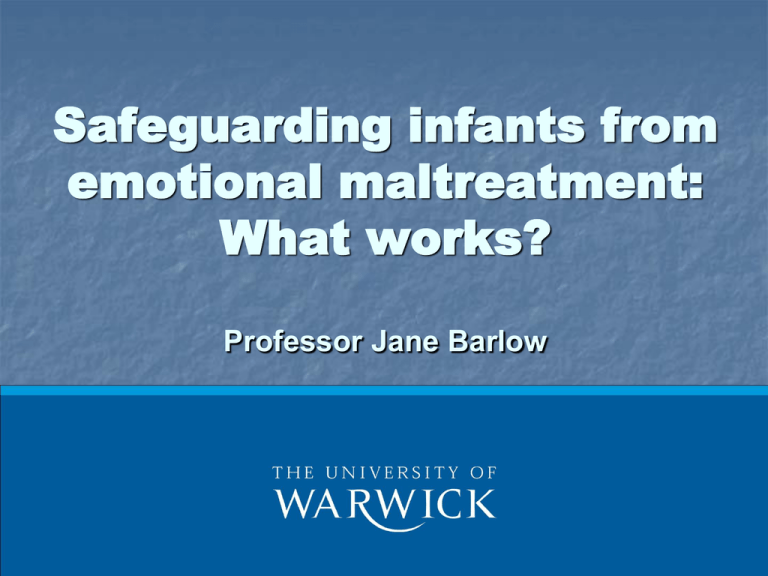
Safeguarding infants from emotional maltreatment: What works? Professor Jane Barlow Structure of paper What is emotional abuse during the first two years of life; Why the first two years matter; What the evidence tells us about ‘what works’ Emotional Abuse Emotional Abuse – the problem Referrals for primary emotional abuse rose from 4,700 (13%) to 5,100 (20%) over past decade This equates to 4.7 per 10,000 children As many as 80% of children registered for physical abuse and neglect have also experienced emotional abuse Subjective Perceptions Large-scale population-based study (involving 2,869 adults) in the UK 6% reported - frequent and severe psychological control and domination; - psycho/physical control and domination, humiliation, attacks on self-esteem - withdrawal of their primary carer’s attention/affection - antipathy, terrorising or threatening behaviours and proxy attacks Five categories defined rejecting: behaviours which communicate or constitute abandonment of the child; isolating: preventing the child from participating in normal social interaction activities; terrorising: threatening the child with severe punishment, or deliberately cultivating a climate of fear or threat; ignoring: where the caregiver is psychologically unavailable to the child and fails to respond to the child's behaviour; and corrupting: caregiver behaviour which encourages the child to develop false social values that reinforce antisocial or deviant behavioural patterns (Glaser and Prior,2002) What is emotional abuse? A constant, repeated pattern of parental behaviour, (unaccompanied by physical abuse, sexual abuse or necessarily by physical neglect) that is likely to be interpreted by a child that she or he is unloved, unwanted, serves only instrumental purposes, and/or which severely undermines children’s development and socialisation (Barlow and Schrader-McMillan 2010) Definition Consistent with WHO definition (1999) Includes acts toward the child that have a high probability of causing harm to their health or to any aspect of their development (physical, emotional or social etc) ALSO includes the failure to provide a developmentally appropriate and supportive environment in which the child can develop the full range of emotional and social competencies commensurate with her or his personal potential Early Development and Later Wellbeing Parenting Self-esteem Smoking/drugs Promiscuity Behaviour Infants’ CNS School failure Mentalising Delinquency Relationships Emotional regulation via attachment Empathy CORE of incipient self Learning Obesity ETC… Trauma in infancy: attachment system compromised. Sensitised nervous system as brain adapts to emotional environme Stress in adult: reminders & experiences of trauma, life events, etc. Unbearably painful emotional states. Retreat: isolation dissociation depression Self-destructive actions: substance abuse eating disorders deliberate self-harm suicidal actions Destructive actions: aggression violence rage Aspects of Early Development Emotional competence Cognitive Development Social Competence Trust/attachment Alertness/curiosity Impulse control Toddlerhood Empathy Communication/ mastery motivation Coping Childhood Social Relationships Reasoning/problem solving Goal-directed behaviour Adolescence Supportive social network Learning ability/achievement Social responsibility Infancy The Social Baby In first 15 hours baby’s distinguish the voice, smell and face of their mother They connect what they do with what happens immediately after Babies have a sophisticated understanding of facial expressions – distinguish between surprise, fear, sadness, anger and delight By 10- months babies seek emotional information from others to help them interpret things around them By 10-months baby’s brain has developed according to the type of emotions to which they have been exposed (Beebe and Lachman, 2004) Affect synchrony Mirroring Parent-Child Interaction Containment Reflective function Infant secure Attachment i. Attachment behaviours ii. Internal Working Model Sense of ‘self’ ‘Affect Synchrony’ – the dance By two months the mothers face is the primary source of visuo-affective communication Face-to-face interactions emerge which are high arousing, affect-laden and expose infants to high levels of cognitive and social information and stimulation To regulate this infant and mothers regulate the intensity of these interactions – ‘affect synchrony’ and repairs to ruptures Absolutely fundamental to healthy emotional development – prolonged negative states are ‘toxic’ to infants Adults that are incapable of ‘attunement’ i.e. intrusive; depressed, cannot regulate appropriately ‘Attuned mutual co-ordination between mother and infant occurs when the infant’s squeal of delight is matched by the mother’s excited clapping and sparkling eyes. The baby then becomes overstimulated, arches its back and looks away from the mother. A disruption has occurred and there is a misco-ordination: the mother, still excited, is leaning forward, while the baby, now serious, pulls away. However, the mother then picks up the cue and begins the repair: she stops laughing and, with a little sigh, quietens down. The baby comes back and makes eye contact again. Mother and baby gently smile. They are back in sync again, in attunement with each other (Fosha, 2003 in Walker 2008, p. 6). Videoclip One Reflective Function Capacity to understand the infant’s behaviour in terms of internal states/feelings A key determinant of self-organization which is acquired in the context of the child's early social relationships (Fonagy, 1997) Development of self-organization is dependent on the caregiver's ability to communicate understanding of the child's intentional stance via ‘marked mirroring’ Lack of parental RF plays a key role in pathological functioning Videoclip two Affect synchrony in the face of parental problems Infant’s emotional states can trigger profound discomfort in the parent (e.g. where there is unresolved loss/trauma, mental health problems, drug/alcohol abuse, or where there is domestic violence etc) Interaction becomes characterized by withdrawal, distancing or neglect (i.e. omission) or intrusion in the form of blaming, shaming, punishing and attacking (i.e. commission) (ibid). Videoclip two The Impact on the Developing Neurosystem The Infant’s Brain – Softwiring Unique wiring of individual brain determines how we behave; think; feel; memories etc and our sense of ‘self’ Wiring takes place during prenatal period to school-entry – important first two years Rapid proliferation and overproduction of synapses followed by loss (pruning) ‘Use it or lose it’ – lost if not functionally confirmed Influenced by genes and environment Most important aspect of the environment is primary care-taker For example… Looks and smiles help the brain to grow Baby looks at mother; sees dilated pupils (evidence that sympathetic nervous system aroused and happy); own nervous system is aroused - heart rate increases Lead to a biochemical response - pleasure neuropeptides (betaendorphin and dopamine) released into brain and helps neurons grow Families doting looks help brain to grow Negative looks trigger a different biochemical response (cortisol) stops these hormones and related growth (Gerhardt, 2004) Babies of depressed mothers: - nearly half show reduced brain activity - much lower levels of left frontal brain activity (joy; interest; anger) Early experiences of persistent neglect and trauma: - overdevelopment of neurophysiology of brainstem and midbrain (anxiety; impulsivity; poor affect regulation, hyperactivity) - deficits in cortical functions (problem-solving) and limbic function (empathy) Attachment What is it:? - Affective bond between infant and caregiver (Bowlby, 1969) What is its function?: - Dyadic regulation of infant emotion and arousal (Sroufe, 1996) Antecedants of attachment: Sensitive, emotionally responsive care during first year – secure attachment Insensitive, inconsistent or unresponsive care – insecure attachment The Importance of Attachment Secure base – to explore the world Prototype for later relations – internal working model is a ‘representational model’ of self and self with other Provide child with expectations in relation to self and others Attachment Majority of children (two thirds) who have sensitive care will form secure attachments – 67% Remaining children will be: - Insecure attachment (i.e. unable to use caregiver to modulate their aroused state) Avoidant – over-regulate; Resistant – under-regulate - Disorganised attachment – no consistent patterns of behaviour - conflicting emotions E.g. 82% of abused cf 19% of non-abused children had disorganised attachment (Carlson, Cicchetti et al., 1989) Disorganised/Controlling Attachment 82% of abused cf 19% of non-abused children had disorganised attachment (Carlson, Cicchetti et al., 1989) Caregivers – unpredictable and rejecting; source of comfort also source of distress Self represented as unlovable, unworthy, capable of causing others to become angry, violent and uncaring Others – frightening, dangerous, unavailable Predominant feelings – fear and anger Little time for exploration or social learning Arousal following trauma Hyper-arousal (aggression, impulsive behaviour, children emotional and behavioural problems – ‘Fight or flight’ response) Window Of Tolerance Hypo-arousal (dissociation, depression, self harm etc) Compulsive Strategies Compulsive compliance (where parent is threatening) – watchful; vigilant and compliant Compulsive caregiving (where parent is needy) – role reversal; parentification; children deny own developmental needs Coercive – combination of threatening and placatory behaviours Controlling strategies (abusive and neglectful) – self is strong and powerful but also dangerous and bad; avoidance and aggression; completely ‘out of control’ and ‘fearless’ Compulsive caregiving ‘Caroline is 18 months old. She lives with her mother, who is chronically depressed. The mother describes the household as ‘noxious to the soul’. She cannot tolerate the idea that her depression is affecting Caroline. She says: “Caroline is the only one who makes me laugh.” It is observed that Caroline silently enacts the role of a clown. She disappears into her room and comes out wearing increasingly more preposterous costumes. Caroline makes her mother laugh, but she herself never laughs…’ (Howe, 1999) Disorganised attachment stems from disruption in the emotional communication, or lack of attunement, between parent and baby. Borderline A withdrawing response.. Strongest predictor symptoms in late adolescence. Negative-intrusive responses.. Hostile / frightening response. A role-confused response. Lack of effective regulation of fearful arousal in infant. (Disorganised attachment.) Disoriented/confused responses. Emotional communication errors, e.g. giving conflicting cues to baby, failure to respond to infant’s signals. Dissociative symptoms in late adolescence. Framework Prevention before occurrence Prevention of recurrence Physical abuse Sexual abuse Emotional abuse Neglect Witnessing IPV Universal Targeted Prevention of impairment Long-term outcomes Prevention before occurrence Nurse Family Partnership Intensive home visits during pregnancy and first two years Goal based; ecological; attachment; self-efficacy etc Reduced child physical abuse and neglect, as measured by official child protection reports Reduced associated outcomes such as injuries in children of first-time, disadvantaged mothers Level of evidence: RCTs Triple P Dissemination of Triple P professional training to the existing workforce alongside universal media and communication strategies, across 18 randomly assigned counties in the US Showed positive effects on substantiated child protection services reports, out-of-home placements, and hospital and emergency reports of injuries Rates of maltreatment rose in both groups Analysis is not clear, and further evaluation and replication is recommended Level of evidence: one RCT Healthy Child Programme Preparation for parenthood Supporting bonding Supporting attachment and addressing early problems Supporting parenting Identifying and supporting high-risk families – teenage parents; domestic violence; parental mental health problems Preventing re-exposure and impairment Key Intervention Approaches Sensitivity/attachment-based: Interaction Guidance; FNP Psychotherapeutic: Parent-infant psychotherapy Mentalisation: Minding the Baby Parenting programmes – Parents under Pressure Parenting Programmes – Circle of Security; Baby Triple P Nurse Family Partnership Intensive home visits during pregnancy and first two years Goal based; ecological; attachment; self-efficacy etc Reduced child physical abuse and neglect, as measured by official child protection reports Reduced associated outcomes such as injuries in children of first-time, disadvantaged mothers Level of evidence: RCTs Interaction guidance Weekly for 10 weeks - reinforcement of adequate maternal behaviours; modification of inappropriate patterns; Video based recordings and coaching of actual interactions 22 FTT mothers and babies significant reduction decreasing atypical behaviours and disrupted communication (Benoit et al 2001) [Tissot et al., 1999] PUP Programme PUP is underpinned by an ecological model of child development and targets multiple domains of family functioning, including the psychological functioning of individuals in the family, parent–child relationships, and social contextual factors. Incorporates ‘mindfulness’ skills that are aimed at improving parental affect regulation; PUP comprises an intensive, manualized, home-based intervention of ten modules conducted in the family home over 10 to 12 weeks, each session lasting between one and two hours PUP evaluation Parents Under Pressure RCT with substance abusing parents of children aged 2-8 years (Dawe and Harnett 2007) Compared PUP with standard parenting programme Significant reductions in parental stress; methadone dose and child abuse potential (significant worsening in the child abuse potential of parents receiving standard care); improved child behaviour problems Mentalisation-based approaches Emerging model of intervention that builds on both parent-infant psychotherapy and recent advances in advances in attachment theory Minding the Baby is an interdisciplinary, relationship based home visiting program for young, at-risk new mothers Delivered by a team that includes a nurse practitioner and clinical social worker- uses a mentalisation-based approach that involves working with mothers and babies in a variety of ways to develop mothers' reflective capacities It aims at addressing relationship disruptions that stem from mothers' early trauma and derailed attachment history Only case-study evidence available (Slade et al., 2005) Parent-Infant Psychotherapy Focus on mother’s representational world e.g. the way in which the mother’s current view of her infant is affected by representations from her own history Fraiberg ‘Ghosts in the Nursery’ Linking of ghosts with mother’s own history facilitates changes to her representational world and new paths for growth of both mother and infant Combined Approaches Watch, Wait and Wonder Infant led parent-infant psychotherapy Mother observes her infant’s self-initiated activity whilst being physically accessible to infant Discussion of these experiences with therapist as a way of examining the mother’s internal working models of herself in relation to her infant RCT of 67 anxiously attached dyads (less than 30 months) Post Intervention Both WWW and PPT were successful in reducing infant presenting problems, decreasing parenting stress, reducing maternal intrusiveness and mother-infant conflict WWW group showed greater shift toward more organised or secure attachment and greater improvement in cognitive development and emotion regulation than PPT group. WWW mothers reported greater increase in parenting satisfaction and competence and greater decrease in depression 6-month follow-up The above differences between the groups had disappeared – the PPT group also showed the above gains Advantage persisted for WWW in mothers comfort in dealing with infant behaviours and parenting stress COS - Findings Participants – 65 toddler/preschooler– caregiver dyads recruited from Head Start and Early Head Start programs; Significant within-subject changes from disorganized to organized attachment classifications, with a majority changing to the secure classification; is a promising intervention for the reduction of disorganized and insecure attachment in highrisk toddlers and preschoolers (Hoffman, Irvine and Powell,2006) Interaction Guidance Interaction Guidance aims at increasing maternal sensitivity & is a brief (6-7 week) intervention designed specifically for families who have been hard to engage and who have a limited capacity for introspection Benoit et al (2001) compared the effect of a playfocused intervention (Interaction Guidance) combined with training on feeding, and training on feeding alone for parents of babies with FG 28 FTT infants and their mothers – controlled study Results showed that a modified version of Interaction Guidance was effective in decreasing atypical behaviours and disrupted communication Parenting Programmes Parents Under Pressure RCT with substance abusing parents of children aged 2-8 years (Dawe and Harnett 2007) Compared PUP with standard parenting prog Significant reductions in parental stress and methadone dose and child abuse potential (significant worsening in the child abuse potential of parents receiving standard care); improved child behaviour problems Mentalisation-based approaches Emerging model of intervention that builds on both parentinfant psychotherapy and recent advances in advances in attachment theory Minding the Baby is an interdisciplinary, relationship based home visiting program for young, at-risk new mothers Delivered by a team that includes a nurse practitioner and clinical social worker- uses a mentalisation-based approach that involves working with mothers and babies in a variety of ways to develop mothers' reflective capacities It aims at addressing relationship disruptions that stem from mothers' early trauma and derailed attachment history Only case-study evidence available (Slade et al., 2005) Parent-infant psychotherapy Mother and infant meet weekly with a therapist for one year Joint observation of the infant, and the therapist aims to ‘allow distorted emotional reactions and perceptions of the infant as they are enacted during mother–infant interaction to be associated with memories and affects from the mother’s prior childhood experiences. the therapeutic relationship provides the mother with a corrective emotional experience, through which the mother is able to differentiate current from past relationships, form positive internal representations (Cicchetti et al 2006) Parent-infant/child psychotherapy Recent research suggests that parent-infant/child psychotherapy may be an effective means of improving parent-child interaction (e.g. Cicchetti et al 2006; Toth et al 2002; Cohen et al., 1999) There is a range of different types of parent-infant/child psychotherapy available - standard representational models of psychotherapy some incorporating behavioural components (e.g. Watch, Wait and Wonder - see Muir (1992) and Cohen et al. (1999) Research suggests that parents with avoidant attachment disorder are better suited to more behavioural than representational models of psychotherapy as a result of their inability to introspect about the role of earlier experiences on current parenting (Bakermans-Kranenburg et al., 2003). Summary Emotional neglect and abuse during first two years are ‘traumatising’ Evidence base about ‘what works’ is developing Interventions that may be effective include: - CBT/affect regulating parenting programmes - Interaction Guidance - Psychotherapeutic approaches including parent psychotherapy, parent infant psychotherapy - Mentalisation programmes
